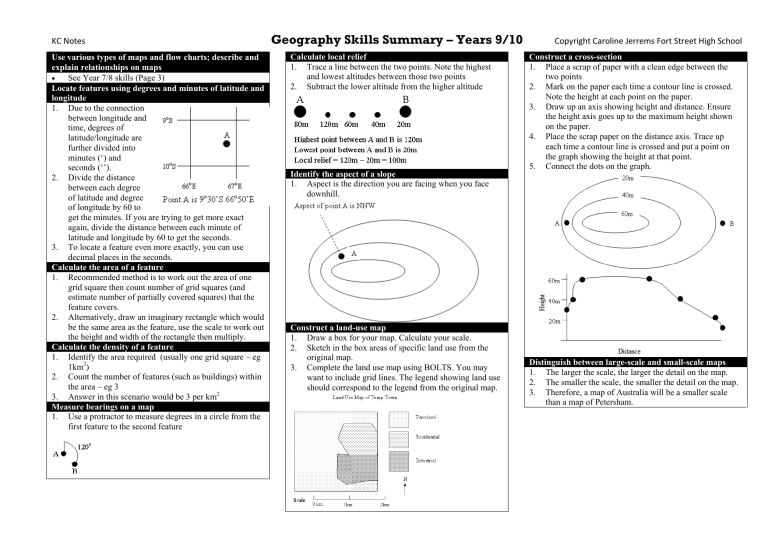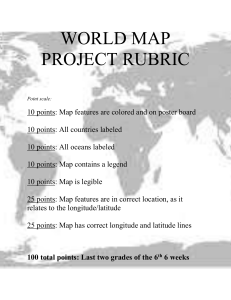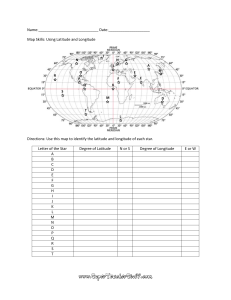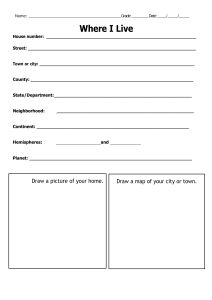
KC Notes Use various types of maps and flow charts; describe and explain relationships on maps See Year 7/8 skills (Page 3) Locate features using degrees and minutes of latitude and longitude 1. Due to the connection between longitude and time, degrees of latitude/longitude are further divided into minutes (‘) and seconds (‘’). 2. Divide the distance between each degree of latitude and degree of longitude by 60 to get the minutes. If you are trying to get more exact again, divide the distance between each minute of latitude and longitude by 60 to get the seconds. 3. To locate a feature even more exactly, you can use decimal places in the seconds. Calculate the area of a feature 1. Recommended method is to work out the area of one grid square then count number of grid squares (and estimate number of partially covered squares) that the feature covers. 2. Alternatively, draw an imaginary rectangle which would be the same area as the feature, use the scale to work out the height and width of the rectangle then multiply. Calculate the density of a feature 1. Identify the area required (usually one grid square – eg 1km2) 2. Count the number of features (such as buildings) within the area – eg 3 3. Answer in this scenario would be 3 per km2 Measure bearings on a map 1. Use a protractor to measure degrees in a circle from the first feature to the second feature Geography Skills Summary – Years 9/10 Calculate local relief 1. Trace a line between the two points. Note the highest and lowest altitudes between those two points 2. Subtract the lower altitude from the higher altitude Identify the aspect of a slope 1. Aspect is the direction you are facing when you face downhill. Construct a land-use map 1. Draw a box for your map. Calculate your scale. 2. Sketch in the box areas of specific land use from the original map. 3. Complete the land use map using BOLTS. You may want to include grid lines. The legend showing land use should correspond to the legend from the original map. Copyright Caroline Jerrems Fort Street High School Construct a cross-section 1. Place a scrap of paper with a clean edge between the two points 2. Mark on the paper each time a contour line is crossed. Note the height at each point on the paper. 3. Draw up an axis showing height and distance. Ensure the height axis goes up to the maximum height shown on the paper. 4. Place the scrap paper on the distance axis. Trace up each time a contour line is crossed and put a point on the graph showing the height at that point. 5. Connect the dots on the graph. Distinguish between large-scale and small-scale maps 1. The larger the scale, the larger the detail on the map. 2. The smaller the scale, the smaller the detail on the map. 3. Therefore, a map of Australia will be a smaller scale than a map of Petersham. KC Notes Calculate the gradient of a slope 1. Gradient formula is Difference in height / Distance. 2. Use contour lines to calculate height and use scale to calculate distance. Express as a fraction. 3. Divide numerator and denominator by the numerator (so the numerator becomes 1) 4. Express the fraction as a ratio. Geography Skills Summary – Years 9/10 Construct a transect 1. A transect in a School Certificate paper shows land use between two points. It is usually displayed on a bar or column chart but can occasionally be used in conjunction with a cross section. 2. Use a piece of scrap paper with a clean edge. Mark on it when land use shown on the map changes. 3. Use the paper to create a bar chart. 4. Use the legend to label the bar chart with correct land uses. Develop a research action plan 1. Identify the aim/purpose of the investigation. 2. Generate a number of focus questions to be addressed by the investigation. 3. Decide which primary and secondary data are needed to answer the focus questions. 4. Identify the techniques that will be used to collect the data. 5. Collect primary and secondary data. 6. Process (eg in a table or graph) and analyse (look for trends and associations) the data collected. 7. Select presentation methods to communicate the research findings effectively. 8. Propose individual or group action in response to the research findings and, where appropriate, take such action. Use fieldwork techniques to collect primary and secondary data 1. Primary Data = data you gather yourself for the purpose of the current investigation eg survey, interview, observations, measurements, take photographs, do a field sketch etc 2. Secondary Data = data that has already been gathered for another purpose eg newspaper articles, census data, research reports etc Copyright Caroline Jerrems Fort Street High School Construct and interpret population pyramids 1. Population pyramids show the number of people at each age group (subdivided into men and women). 2. It allows analysis of birth rates, death rates, developing/developed country status, ageing population issues etc. Construct and interpret divided bar and column graphs, and composite line graphs Divided bar chart Divided column Composite line graph chart Recognise and account for change using statistical data 1. Refer to year 7/8 skills 2. Percentage change = New – Old eg 10-8 = 25% Old 8 Read and interpret synoptic charts See Year 7/8 skills (Page 3) Interpret satellite images; collect and use digital images Refer to year 7/8 skills (Page 3) KC Notes Use various types of maps 1. Physical maps show landforms using colours and shading 2. Political maps show borders of nation-states 3. Topographic maps show altitude using contour lines 4. Thematic maps focus on one factor (eg water consumption, income) – usually using a choropleth map (different colours show different levels of the factor) Identify and use elements of maps B Border O Orientation (direction of north) L Legend T Title S Scale Measure distances on a map using a scale Geography Skills Summary – Years 9/10 Distinguish between different types of photographs 1. Oblique photos are taken from an angle – they show height well but distances are inaccurate 2. Aerial photos are taken from directly overhead – they show distance (as the crow flies) accurately but don’t show height of features 3. Ground level photographs show details well but don’t always put them in perspective 4. Satellite imagery shows large areas and can also show thematic information such as soil type or deforestation Construct and interpret basic graphs 1. Bar, column and line charts are useful for showing changes between values 2. 3. Climate charts show precipitation (rainfall) and temperature together, allowing meaningful analysis of climate patterns. Proportional graphs – either bar or pie – allow comparison of the relative components of different sets of data Collect and interpret photographic images 1. Photographs can be interpreted to analyse geographic information. Do not just put photographs in assignments as pretty pictures – caption them to analyse the implications of what you see in them. Identify and calculate key statistics 1. Maximum = highest value in the sample 2. Minimum = lowest value in the sample 3. Total = all the values in the sample added together 4. Range = highest value minus lowest value 5. Rank = reorder values from highest to lowest (or vice versa) 6. Average (mean) = divide the total of the sample by the number of values in the sample Copyright Caroline Jerrems Fort Street High School




